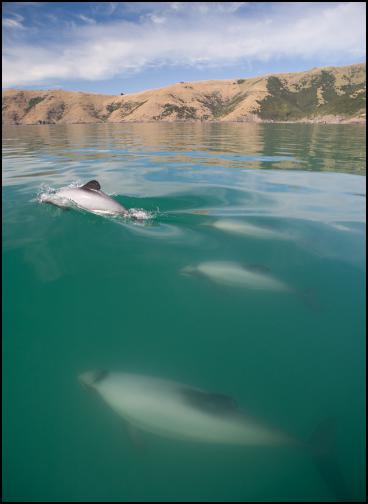Dolphin protection boundaries not matching up with research

Photo credit; Steve Dawson. Hectors off Onawe mid-winter - show Hector's dolphins well within the flounder area in mid-winter.
Dolphin protection boundaries not matching up with research results off Banks Peninsula
11 July 2013
Scientists say Banks Peninsula is a very good example of ‘where dolphin protection boundaries don’t match up with the scientific results of research,’ after being surprised to find the endangered Hector's dolphin frequenting even the ‘innermost parts of Akaroa Harbour’ after a yearlong study.
Otago University researchers Steve Dawson and Liz Slooten say their year-long study shows Hector's dolphins are in Akaroa Harbour much more than thought during the winter months, but what was surprising was the dolphins' use of the innermost parts of the popular harbour, ‘where the flounder fishing happens,’ was surprisingly high.
“The recent work was an acoustic study, using echolocation loggers that listened 24/7,” Dawson said. “That's a real strength of the research, because no visual study could do that.”
The loggers were located in three locations and survived several storms over the course of 12 months, which was ‘a real challenge.’
They say this adds to a very strong argument that set net fishing in Akaroa Harbour should be completely banned as Hector's dolphins are at high risk of being killed in the nets. Set nets are currently banned during the summer months in the harbour.
The university marine researchers would also like to see set nets banned under the Fisheries Act for 20 nautical miles off shore (35 kms); it is currently only four miles.
“Banks Peninsula boundaries currently are an “unfortunate mix of science, politics and economics,” Dawson said.
“Dolphins are worth much more alive. Marine tourism in Akaroa Harbour is worth more than recreational fishing. It is very strange to have dolphin tourism at one end of the harbour and fishing using set nets which entangle and kill dolphins, at the other end.”
Dawson said research results showed that Hector's dolphins live in water up to 100 metres in depth, and that is the depth off Banks Peninsula to about 35 km off shore.
Managing Director of leading Banks Peninsula tourism operator Black Cat Cruises Paul Bingham said the company was fully supportive of a complete ban.
“A small risk is too much risk given the fragile state of the population; our customers would be fully supportive,” Bingham said.
Bingham agreed that the current protection of the endangered Hector's Dolphins in Canterbury was just not good enough, and that set nets should be banned under the Fisheries Act for at least twice of the current four nautical miles along the entire east coast of the South Island.
“Any death of a dolphin is significant for a population of only 900 around Banks Peninsula. It is a serious issue and we need Central Government to take some action. These dolphins are particularly at risk of getting caught in set nets and drowning.”
Bingham said that Hector Dolphins numbers were still in decline and that it was extremely important more action was taken to increase the protection in place.
Ends


 Gordon Campbell: On The Government’s Latest Ferries Scam
Gordon Campbell: On The Government’s Latest Ferries Scam NZ Government: Reducing Ambiguity About What Is Reasonably Practicable For Health And Safety Compliance
NZ Government: Reducing Ambiguity About What Is Reasonably Practicable For Health And Safety Compliance Office of the Speaker: New Zealand Parliamentarians Attend 150th IPU Assembly
Office of the Speaker: New Zealand Parliamentarians Attend 150th IPU Assembly RNZRSA: RNZRSA Supports Willie Apiata VC's Stand To Drive Change To Veterans’ Support Act
RNZRSA: RNZRSA Supports Willie Apiata VC's Stand To Drive Change To Veterans’ Support Act Diane McCarthy - LDR: War Hero Willie Apiata Entrusts MP With Victoria Cross Medal
Diane McCarthy - LDR: War Hero Willie Apiata Entrusts MP With Victoria Cross Medal PSA: Disappointing Govt Attack On Diversity, Inclusion In Public Service
PSA: Disappointing Govt Attack On Diversity, Inclusion In Public Service NZ Labour Party: Govt Health And Safety Changes Put Workers At Risk
NZ Labour Party: Govt Health And Safety Changes Put Workers At Risk


